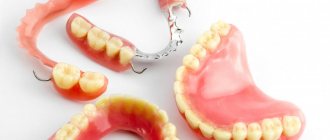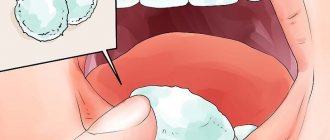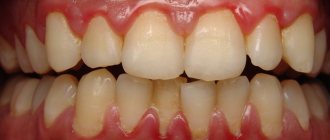What are the symptoms of flux?
The key stages of development and symptoms of flux are:
- Initial. During chewing, pain is felt, which gradually intensifies, developing into a constant pain.
- Second. It is characterized by redness of the gums around the sore tooth, followed by slight swelling. If the disease is not treated at this stage, the compaction will eventually develop into an abscess.
- Third stage. The cheek on the side of which the flux develops becomes swollen. Swelling of the chin and lips may also occur.
- Next, the patient’s temperature rises, and throbbing pain radiates to the temples, ear and eye areas.
If the symptoms are ignored and treatment is not started in a timely manner, there is a possibility of complications developing, which in some cases can be fatal. The disease progresses very quickly, and there are frequent cases of the subsequent occurrence of phlegmon, which is a purulent inflammation of the tissue. The latter, in turn, can lead to blockage of the airways.
What to do if your gums bleed during pregnancy?
First, rinse your mouth with infusions of medicinal herbs, which are allowed during pregnancy. For example, an infusion of walnut leaves, linden blossom, chamomile, and a decoction of the herb cinquefoil should be taken with caution. You can buy a ready-made Rotokan rinse solution at the pharmacy. In addition, rinse the mouth with a solution of chlorhexidine (0.05%).
Secondly, treatment and prevention of gum inflammation involves the use of Kalanchoe juice, which is rubbed into the gums. For these purposes, you can also use a mixture of honey and salt (1:4). It will not hurt to use ready-made dosage forms, for example, Metrogil-denta or Cholisal. Of course, before using any medicine, you should consult with your doctor about possible contraindications.
Thirdly, you shouldn’t hope that everything will go away on its own. This is wrong. Over time, minor gum problems can develop into much more serious problems if left untreated. If you experience persistent, prolonged pain or your gums are bleeding, you should immediately consult a doctor. In this case, you should inform him about your situation if it is not visually noticeable yet, because during pregnancy you cannot do x-rays, as well as some types of anesthesia.
You will also need to consult a doctor if your gums are swollen and red, or if plaque quickly appears when brushing your teeth regularly. If the doctor considers treatment necessary, then it would be more advisable to resort to it in the second trimester of pregnancy, when such measures will already be safer for the pregnant child.
Why does flux occur?
In order to find out how to treat gumboil it is necessary to find out the causes of its occurrence. The main ones are considered to be:
- Advanced caries, as a result of which the tooth is affected by bacteria.
- Jaw injuries resulting in internal hematomas or inflammation of bone tissue.
- Mechanical damage to the gums from solid food particles.
- Inflammation of the gum pocket located between the gum and tooth.
- Complications due to poor quality or untreated periodontitis or pulpitis.
- Tooth extraction during an infectious disease of the patient (flu or sore throat).
- Hypothermia is also one of the possible causes.
Flux classification
Flux on the gums can have several types, which are characterized by individual characteristics of the damage to the periosteum and gum tissue:
- Ordinary flux. Pathogenic bacteria are not involved in the formation of this disease. This is an acute aseptic disease.
- Fibrous periostitis is a consequence of periodic exposure to thermal and other irritants on the gum surface. The consequence of this is thickening of the periosteum. This disease is chronic.
- Periostitis ossificans, which appears with prolonged irritation of the periosteum and is also a chronic disease.
- Odontogenic purulent flux is the result of the penetration of pathogenic microorganisms into gum wounds. Often purulent osteomyelitis occurs, due to which the tooth can be removed.
- Serous albuminous flux (photos of which you can easily find on the Internet) is a serious disease characterized by fluid formation and inflammation.
Recommendations to help avoid problems
In order not to become one of the pregnant women suffering from gingivitis (and, according to statistics, there are more than 60%), you must adhere to simple rules.
- Carry out the necessary hygiene procedures regularly: brush your teeth using a toothbrush with soft bristles, and do this as thoroughly as possible, use floss and antiseptic rinses.
- Avoid excessive amounts of sweets and consume sweets, chocolate and cakes in moderation. It is strongly recommended to refrain from chewing toffee and caramel, since the remains of viscous delicacies can accumulate in the periodontal space of swollen gums, provoking particularly active proliferation of microorganisms.
- Eat more vegetables and fruits, paying special attention to foods containing vitamin C.
Treatment of gingivitis in pregnant women cannot be postponed until later. Occurring due to changes in hormonal status and the growth of microbial microflora, it provokes even more active proliferation of bacteria, which in the most severe cases can cause intrauterine infection of the fetus.
Flux in children: features, symptoms, treatment methods
Flux in a child is characterized by swelling in the area of inflammation and swelling of the cheek, which the baby feels pain when touched. The causes may be: insufficient oral hygiene, the development of infection in a carious tooth, inflammation of the gums, mechanical damage and trauma to the tooth, past infectious diseases. Symptoms include:
- aching toothache that can get worse when you chew food;
- the appearance of swelling in the area of the chin, cheeks and lower eyelid;
- the formation of a purulent lump on the gum;
- unpleasant odor from the mouth.
If your child has gumboil, only a qualified specialist can tell you what to do. He will determine the treatment format depending on the degree of development of the disease. A purulent abscess requires surgical intervention, which is performed under local or general anesthesia. It is also possible to completely remove the tooth. After the operation, the patient is prescribed antibacterial therapy, and, if necessary, antibiotics. To speed up the elimination of the consequences of the disease, rinsing with herbal tinctures and medicinal solutions is recommended.
How to treat flux? Let's consider the main methods of treatment
How to cure flux? The answer is simple - you need to seek help from professionals. Modern dentistry “Orthodent” practices two treatment options:
- Drug therapy (is effective only in the first stages of development of this disease).
- Surgical treatment, involving surgical intervention, which is required in the case when a purulent focus has already appeared on the gum and the disease is advanced.
*there are contraindications, specialist consultation is required
Features of drug therapy
You should contact the dentist immediately after the first toothache appears, since this is the first symptom of a developing disease. Dental treatment for flux diagnosis includes several stages:
- Removal of edema with elimination of the inflammatory focus. At this stage, various antibacterial drugs and antibiotics are used for flux. In order not to make a mistake in their choice, it is necessary to take into account the stage of development of the disease and the individual characteristics of the patient’s body, as well as his reaction to certain medications.
- Dental treatment, that is, eliminating the cause that caused the gumboil to appear.
- Prescribing strengthening drugs, such as calcium glucanate, immunomodulators and vitamins.
Surgery
In the event that drug therapy is powerless or the inflammatory process has already developed quite seriously, surgical intervention is used, which involves the following steps:
- The patient receives a certain dose of painkiller.
- The doctor opens the abscess by making a small incision in the gum located near the gumboil. Next, the purulent exudate is removed. In order not to interfere with the constant outflow of pus, it is necessary to drain the gums.
- Next, the patient is sent for an x-ray in order to identify the main cause of the flux, which will determine the format of further treatment.
- If the tooth cannot be restored, it is removed. The open wound is completely cleared of pus, after which drainage is installed. The patient is advised to take antibiotics.
- Complications after the pus has been removed and the swelling has been eliminated are treated with laser, iontophoresis or ultrasound.
Prevention
She should pay attention at the stage of planning motherhood. It is very important to eliminate existing dental problems in a timely manner. Every woman needs to visit a specialist’s office for treatment of damaged teeth.
To avoid undesirable consequences, you should:
- carry out regular oral care;
- carry out preventive measures to prevent the occurrence of caries;
- eat right, including foods rich in calcium, phosphorus, and magnesium in your daily menu.
At the first alarming symptoms, you should immediately consult a doctor. Remember that at the initial stage of development, eliminating the disease is not at all difficult.
Treatment of flux at home
Dental treatment in Tyumen involves both traditional and traditional medicine. Doctors often prescribe herbal decoctions for patients to rinse the mouth. Such products are characterized by an excellent disinfectant effect and contribute to the rapid elimination of swelling after the pus is removed during the operation. They can also reduce pain.
It is strictly prohibited:
- Take analgesics immediately before going to the dentist.
- Warm up the area where the flux appears. This way you can only accelerate the development of the inflammatory process, thereby causing serious complications in the future.
- Drink aspirin and other painkillers after surgery, as this can lead to bleeding.
How to treat flux at home?
Some of the most effective traditional medicine for treating gumboils on the cheek is an infusion of sage, St. John's wort, calamus root and yarrow. You can use each of these components separately, but a better effect can be achieved by using a collection of these herbs. For example, the most common is an infusion prepared on the basis of St. John's wort. Rinsing should be done with a warm solution every hour and a half and after each meal.
Bee products such as propolis, honey or wax have an excellent effect. Based on them, a number of medicinal ointments have been prepared, which must be applied to the inflamed area at night. Let's take a closer look at each of the options:
- Honey ointment. To prepare it, you need to heat a little honey. Next, take a nail and heat it red-hot, then dip it in hot honey, which should become dark in color, like tar. Apply to the inflamed area at night.
- Beeswax ointment. You need to melt a small piece of wax in 200 grams of sunflower oil. Next, pre-pounded yolk is added here. The prepared product should be heated for 5-7 minutes. Strain it while it is hot. This ointment should be kept in the refrigerator and warmed before use.
- Propolis ointment. Heat 100 grams of butter in a bowl. Add crushed propolis (about 30 grams) to it. Cook for 30 minutes in a water bath. The resulting mixture must be strained while it is hot. Storage can also be carried out in the refrigerator.
*there are contraindications, specialist consultation is required
What dental treatment is prohibited during pregnancy?
When treating teeth during pregnancy, you need to know what is strictly prohibited for expectant mothers.
As a substance for local anesthesia, it is prohibited to use those compositions that contain adrenaline and any of its derivatives. General anesthesia during pregnancy is also strictly prohibited.
Teeth whitening is prohibited. Dental prosthetics cannot be performed. It is prohibited to perform dental treatment using arsenic during pregnancy. Dentists are aware of all the restrictions and your task, in case your pregnancy is short, is to warn the doctor about pregnancy before starting dental treatment.
Recovery period
Even advanced medical technologies cannot provide instant recovery. Therefore, you should not expect the dentist to perform a miracle and your swelling will disappear instantly. It takes some time for the tissue to recover. Within a few hours after surgery, you may even notice that the swelling has increased slightly. But this is an acceptable reaction of the body to surgery. Complete resorption of edema usually occurs on the 3rd day.
The level of pain will begin to decrease within a couple of hours after the operation, and the temperature will also gradually decrease. In this case, there must be a rubber strip in the mouth, which will not allow the wound to heal. This is necessary for the pus to come out. If this gasket falls out, you should seek help from your dentist again. After the operation, the wound may ache for one day.
Remember that if you contact a specialist in a timely manner, the flux can be eliminated in no more than three days. For a complete recovery, it is necessary to undergo longer therapy aimed at the underlying dental disease, which led to the development of periostitis.











